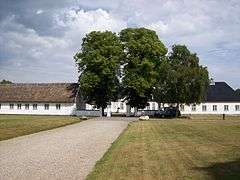Gammel Holtegård
| Gammel Holtegård | |
|---|---|
 | |
| General information | |
| Architectural style | Baroque |
| Town or city | Holte |
| Country | Denmark |
| Coordinates | 55°49′44″N 12°31′03″E / 55.8289°N 12.5175°ECoordinates: 55°49′44″N 12°31′03″E / 55.8289°N 12.5175°E |
| Construction started | 1755 |
| Completed | 1757 |
| Client | Architect's own use |
| Design and construction | |
| Architect | Lauritz de Thurah |
Gammel Holtegård is a former country house in Rudersdal Municipality north of Copenhagen, Denmark, today operated as an arts centre and a museum. It was built by the Danish Baroque architect Lauritz de Thurah for his own use in 1757. Its original Baroque gardens were reconstructed in 2003.
History
In 1755 Lauritz de Thurah acquired an agricultural property, a former tenant farn, in order to establish a suitable country house for himself outside Copenhagen. Simultaneously he was also building a town house for himself in Amaliegade in Copenhagen's new Frederiksstaden district, the responsibility of which he had been assigned after Nicolai Eigtved's death the previous year. Prior to that, he had lived some years at his Børgum Estate to which he had retired when his Baroque style fell out of favour and most of the prestigious assignments in the capital went to Eigtved.
To begin with he demolished the old farmhouse and laid out a large garden à la française with symmetrical plantings of fruit trees and flowering plants, bounded by lime tree avenues. When the new buildings were completed, it included farm buildings and a royal privileged inn.
The house was completed in 1757. It was a single-storey, three-winged building with a hip roof topped by a flèche. Lauritz de Thurah had the two clocks specially cast for the building. The estate also included agricultural buildings and a royal privileged inn. However, de Thurah died just two years after his new house was completed.
At the beginning of the 20th century, the estate was owned by Hans Niels Andersen, founder of the East Asiatic Company. He conducted a thorough restoration of the main building with the assistance of the architect Vilhelm Holck. Holch also added a frontispiece to the main wing.[1]
In 1976 Søllerød Municipality, now part of Rudersdal Municipality, acquired the main building and after an Europa Nostra-awarded adaption into an exhibition space from 1979–83, Gammel Holtegård opened to the public in 1982. In 1994 Gammel Holtegård was taken over by a foundation which now owns and operates the place.[1]
Architecture and gardens
From the outside, the main building appears largely as it did when it was completed in 1757, save the frontispiece added in 1900. The Baroque gardens were reconstructed in 2004. The lime tree avenues are those originally planted by de Thurah. A group of beech trees of an unusual cultivar with palmately lobed leaves is also from his day.
Gammel Holtegård today

Gammel Holtehård is mainly a venue for temporary exhibitions. It also houses a local historic archive and a collection of Stone Age findings from nearby Vedbæk.
The agricultural buildings and most of the land was sold off in 1897. It was acquired by Søllerød Municipality in 1934 and has since 1975 been used for a golf course among other things.[1]
The Vedbæk Finds
Gammel Holtegård also houses the so-called Vedbæk Finds from the Bøgebakken archaeological site, a Mesolithic cemetery of the Ertebølle culture. An example of the findings of this culture cemetery include the bodies of a young woman with a necklace made of teeth, and her newborn baby. The child is cradled in the wing of a swan with a flint knife at its hip. The child's gravegoods suggest that the culture involved ascribed status – the passing of power between generations. The brief statistical findings of the cemetery are as follows; 22 individual bodies (4 newborns), 17 of the adults buried could be aged - 8 died before reaching the age of 20. There were 9 men, 5 of them over the age of 50, and 8 women: 2 died before the age of 20, 3 living to over 40. Two women died in childbirth (including the young woman mention above) and were buried with their newborns beside them. Infant mortality rate is around 35%. Mortality rate is 50%. Reasons for these high death rates could be physiological or cultural.
The cemetery is located in the northern part of the Maglemosen peat bog, and was discovered in 1975 during excavation for the new Vedbæk School. (It should not be confused with the earlier Maglemosian culture, named for a different Maglemose near Slagelse.)
List of owners
- 1697 J.B. Clodi
- 1719-1724 W.B. Clodi
- 1724-1735 Rasmus Rasmussen
- 1735-1742 Karen Soelgaard
- 1742-1755 Jørgen Lassen
- 1755-1760 Lauritz de Thurah
- 1760 Chr. Ditlev Reventlow
- 1760-1776 Johan Eilitz
- 1776-1794 Jacob Schnell
- 1794-1799 Adam Gottlob Wiihm
- 1799-1807 Knud Frederik Juel
- 1807-1808 Johannes Mehldahl
- 1808-1816 Mægler J.C.F. Gandil
- 1816-1830 Ritmester Ernst David Recke
- 1830-1834 Johannes Jung
- 1834-1845 Louise Augusta Jung
- 1845-1855 Carl Philip Holm
- 1855-1866 Frantz Peter Hagen
- 1866-1872 Frederik Gottschalck Knuth
- 1872-1882 Lars Trolle
- 1882-1900 Erhardt Kogsbølle
- 1900-1911 Hans Niels Andersen
- 1911-1943 Axel S. Dahl
- 1943-1947 Holger Schrøder
- 1947-1950 Asger Schmidt
- 1950-1973 N.J.H. Suhr
- 1973-1976 Søllerød Golf Club
- 1976-1993 Søllerød Municipality
1993- Gl Holtegaard-Breda Fonden
References
- 1 2 3 "Gammel Holtegård". Gyldendal. Retrieved 2010-01-23.
Sources
- Gl. Holtegaard FKD
External links
| Wikimedia Commons has media related to Gammel Holtegaard. |